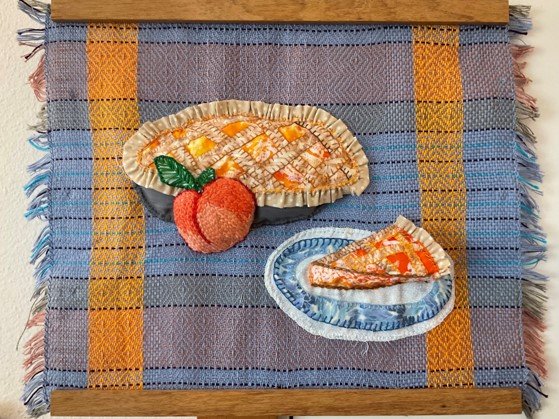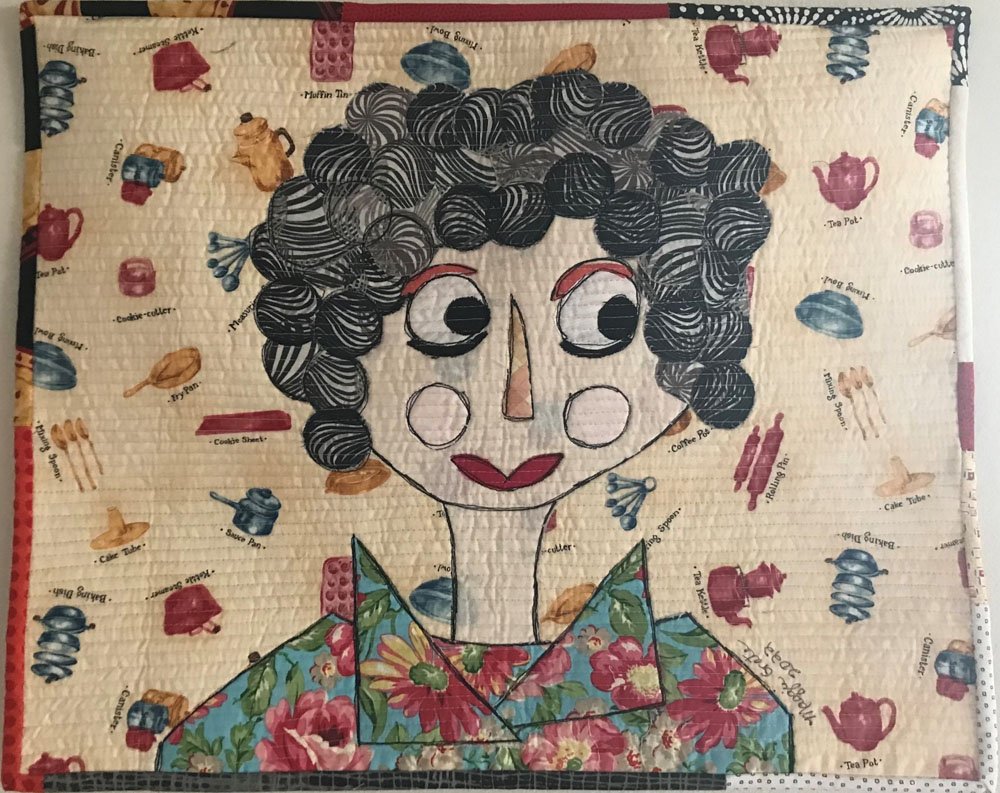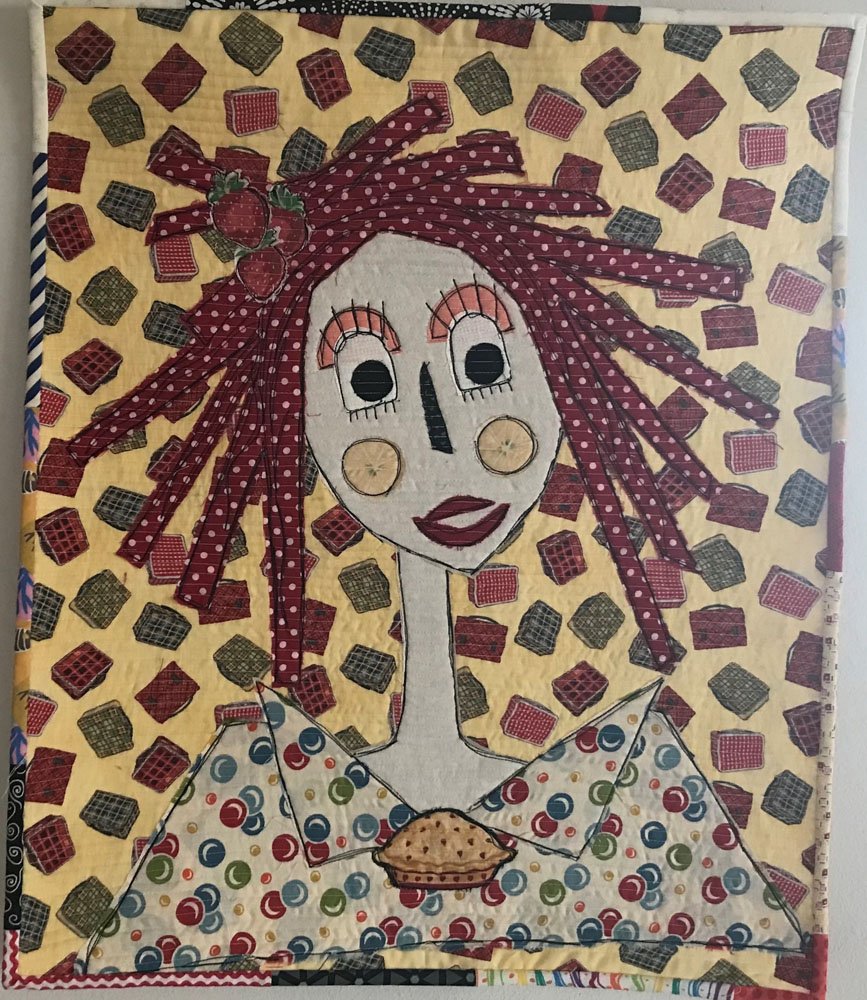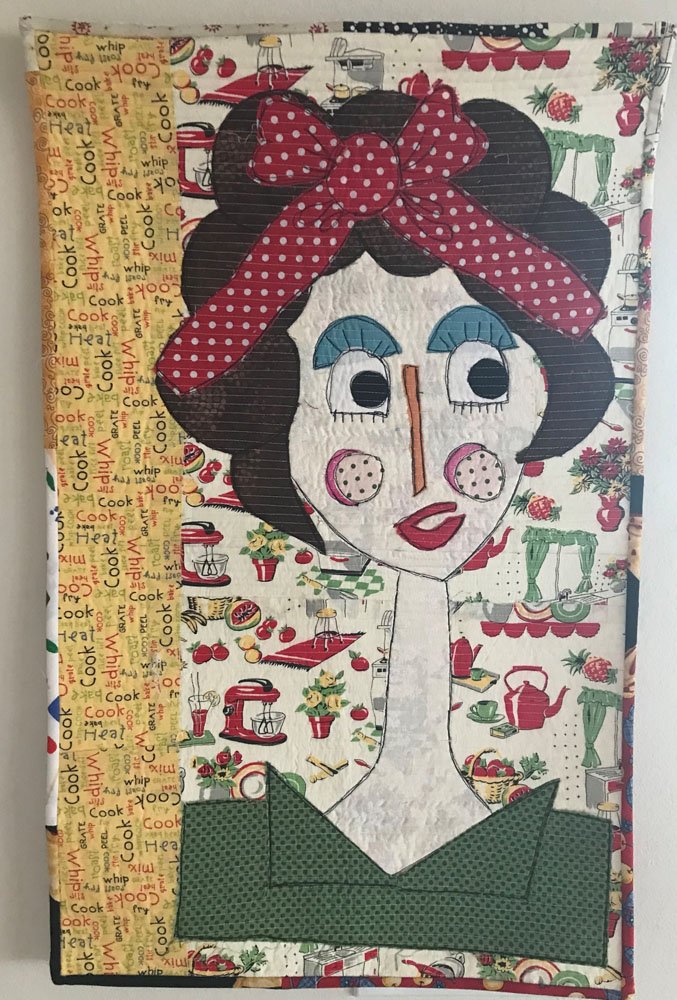WHAT’S FOR LUNCH?
The Esther Webster Gallery At
The Port Angeles Fine Arts Center
March 17th — May 14th 2023
Definition: Inspired by the advocacy of child nutrition programs by a long-ago dietitian, the members of Peninsula Fiber Artists and the Port Angeles Fine Arts Center partnered with ArtsWA, school districts, tribal preschools and food banks to create “What’s for Lunch?”
Textile art in many different media represent traditional school lunches, kids’ favorite treats, the cuisine that many of us enjoy as adults, and the people who grow and prepare food, especially gardeners and school lunch cooks. Our collaboration prompted the development of programs for young children and elementary grades that integrate art and science lessons with the concept of school gardens. Visitors of all ages to this exhibit are encouraged to support the Port Angeles Food Bank
Participants: Barbara Houshmand, Barbara Ramsey, Caryl Fallert-Gentry, Cindy LeRouge, Dale Walker, Debra Olson, Diane Williams, Donna Dowdney, Donna Lark, Erica Iseminger, Evette Allerdings, Irene Bloom, Jeri Auty, Joyce Brustad Gordon, Joyce Wilkerson, Kathie Cook, Leslie Dickinson, Lissa Fagerlund, Linda Carlson, Lynn Gilles, Maggie Grate, Marilyn Heistand, Mary Tyler, Pamela Hastings, Pat Herkel, Terry Wolf
For a detailed Powerpoint presentation with more photos of the artwork and photos of the opening click here
Barbara Houshmand
Port Townsend
BarbaraHoushmand@gmail.com
Love Kids and Mrs. Lunch
Description : TBD
Barbara Ramsey
Port Townsend
bramsey53@gmail.com
510-384-0713
Ode to Meret Openheim
$100
Meret Oppenheim (1913-1985), was a German-born Swiss artist most famous for her fur-lined teacup, created in 1936 and simply titled “Object”. This iconic work subsequently became the first piece by a female artist to be purchased by the Museum of Modern Art in New York. Oppenheim’s work embodies many art movements of the 20th century, particularly Dada and Surrealism, but she is celebrated as an original thinker who followed her own vision. In addition to sculpture, Oppenheim produced paintings, drawings, jewelry, artists’ books, and mixed media pieces. She constantly challenged society’s definition of male and female and encouraged her audience to tread the line between reality and dreams. She believed in the “androgyny of the mind” and said, “freedom is not given to you, you have to seize it.” Above info modified from Oppenheim’s artist bio on the National Museum of Women in the Arts website
Caryl Bryer Fallert-Gentry
Port Townsend, WA
caryl@bryerpatch.com
www.bryerpatch.com
360-385-2568
Cindy LeRouge
Port Townsend, WA
cynlerouge@gmail.com
Iconic Eats
14” X 30”
$325
Materials and Techniques: Mixed media: Paper made using dyed flax roving, Computer designed images (with Carlos Zamora) printed using Spoonflower, sashiko stitching, fabric hand-dyed by Caryl Bryer Fallert, painted sticks
According to national statistics, one in five children and adolescents are overweight or obese. The featured food images in this piece were derived from icons resulting from my research involving Smartphone apps to assist overweight and obese adolescents with self-managing healthy eating. The research was a user-centered design project with the color and style of the images inspired by data collected from teens enrolled in after school and summer healthy behavior programs. My scientific research focuses on leveraging technology to raise awareness and help the afflicted manage challenging health conditions. Art inspired by these efforts helps extend the message.
Dale Walker
dalefarwalker@gmail.com
Bainbridge Island
Peach Pie
16” x 13”
$400.00
When I was told the topic, I thought of fruit, then fruit pie. Peach pie and Pie Slice filling is made up of monoprinted fabric. The peach is embroidered using tapestry wool. All hand embroidered. The placemat background is hand woven on a 4-harness loom.
Terri Wolf — Quilts
98 Paradise View Lane
Port Ludlow
916-616-1256 (c)
terriwolf@mac.com
DEBRA E. Olson
debolson747@yahoo.ca
http://www.itzadebdesign.com
Diane Williams
queenmab50@gmail.com
Port Angeles
The Fate
25” X 32”
$400.00
Materials and Techniques: Hand dyed and Commercial fabrics, free- motion and hand embroidery, piecing, fabric paint on canvas fussy cut then fused.
I made a beautiful late summer Gravenstein apple pie with apples fresh from my tree and no one wanted a piece. I heard a lot of excuses. When the fruit flies started to swarm over the pie, I wondered how I could render them in embroidery. I created this piece in honor of a beautiful pie that fell victim to food waste basted on myths and fears. Apples should be enjoyed, celebrated, and eaten for lunch.
Donna Lark
Larkstudios511@gmail.com
734-347-9602
DonnaLarkFelts.com
Redmond
Inner Beauty: A Mink’s Tale
A furrier would have laughed at the notion that this mink coat was restorable! Dry, brittle, with numerous holes in the shoulders and elsewhere, its fragility demanded innovation.
Keeping with the spirit of this group challenge, the coat was reimagined and reconstructed. Old lining was removed, pelts reconditioned four times with olive oil and vinegar, brittle pelts cut out, new restored pelts sewn in, nunofelted material made to act as lining and support. The result? Mink coattails and a lovely confusion as to which is the inside and which is the outside
Donna Lee Dowdney
Bainbridge Island
donnaleedowdney@gmail.com
(360) 490-0176
Donnaleedowdney.com
Erica Iseminger
Chimacum, WA
eeisemi@gmail.com
360 7320562
ericaiseminger@instagram.com
Zen Salad
12” x 12” x 4”
$300.00
Bowl constructed of cherry bark, cherry wood sticks and anodized aluminum wire. Stones gathered from the beach wrapped in botanically dyed cane.
Making something out of cherry bark harvested from a tree I took down has been in the back of my mind for quite some time. Making a bowl and filling it with something was the perfect opportunity to use the bark in the theme of What’s For Lunch. The color and texture of the bark is like taffeta . Using and highlighting something that would be burned as firewood or consigned to the compost pile brings joy to me – a gift from the forest
Evette Allerdings
eallerdings@gmail.com
808-396-7040
evetteallerdingsstudio.com
The Shrinking Water Hole
$400
Historically, only royalty and the very wealthy wore the finest silk and furs. I used that symbolism to depict our current and future competition for less and less resources, housing, food, and water. Where do you fare in this struggle to survive.
Irene Bloom
Port Townsend, WA
bloomwrite@gmail.com
(360) 390-8641
Bento Box
8” X 8 ¼”
NFS
Bento Box, the traditional Japanese, single portion meal, is both nutritional and aesthetically pleasing. It is common for mothers to prepare a bento box each morning for their school childrens' lunch.
I was inspired to make my version out of fabric after having a bento box lunch with my Japanese daughter-in-law at our favorite Seattle restaurant.
Jeri Auty — Quilts
Port Ludlow
360-390-8170
jeriauty@gmail.com
Recycle/Upcycle
NFS
I am a quilter so I work in 2D. Working in 3D was a new experience for me. I wanted to create pieces that represented recycling and up cycling of the fur of Gene White mink coat that she wore for years, especially around Seattle. The part of the coat I received was a bit of the sleeve that was very well worn and fragile and needed to be handled with care. Not only was the mink of the coat up cycled but so was an old beret of mine, a bead necklace and a bit of twine. I like to think that Gene White would have enjoyed wearing both the hat and necklace with her mink.
Joyce Brustad Gordon
Nordand
2swedishchicks@gmail.com
503-869-2773
Salish Sea Trio
2021
NFS
The change of seasons in the Salish Sea with its cycles of nature are observed and determined by the rhythm of the light. Salish Sea Trio explores that rhythm of light with Pacific Coast Oysters, Spot Prawns and Dungeness Crab.
Oysters revealed in shallow water are easily retrieved and featured as ‘oysters on the half shell.'
Spot prawns living in the shadows in the darkest depths of the sea receive a rude awakening as they break the surface in a chaotic reaction to the light.
Dungeness crab take cover in the kelp, affected by the rhythm of the tide, emerging only in the slight ripple of light to feed.
Joyce Wilkerson
Port Townsend
jwweave@gmail.com
360-379-4075
I’m Having Spaghetti
16” x 23”
$ 150
After I googled “school lunches”, I decided to provide my idea of a tasty and nutritious lunch for kids. Yes, to salad and some carrots. Spaghetti with meatballs and green olives - yum yum. Delicious Washington cherries and a beautiful apple for dessert!
Kathie Cook
Sequim
Kathie.l.cook@gmail.com
907-978-7030
Everyone Needs A Good Lunch
39 “ wide by 22” high
NFS
This is an improvisational pieced quilt with photos printed at Spoonflower.
The quilt is 100% hand pieced and hand quilted.It is made of commercially printed cottons and photos printed on cotton.
My quilt was inspired by the need for every living creature to have good meals. The photos are of my family, the furry critters that are my pets and the animals we care for in our yard.
Leslie Dickinson
Port Townsend
Ldakm@msn.com
360-379-2404
Instagram – PTLeslie
Bowl of Cabbage
21” x 21” x 6”
Kaffe (Phillip Jacob) brassica prints in every color offered. Collaged, stitched and beaded.
Liisa Fagerlund
fagerlund@hotmail.com
360-460-8527
Linda Carlson
Sequim
lindacarlson@earthlink.net
360-504-3498
lindacarlson.com
Lynn Gilles
Ikayak09@gmail.com
386-225-6929
Maggie Grate
maggiegrate@comcast.net
Port Townsend
Marilyn Hiestand
wovenwind793@yahoo.com
Port Angeles
Eat Local
20” x 24”
Price: $200
Paper, cloth, Watercolor and collage
I like the idea of eating local as explained below:
Local food (or "locavore") movements aim to connect food producers and consumers in the same geographic region, to develop more self-reliant and resilient food networks; improve local economies; or to affect the health, environment, community, or society of a particular place.
What are the benefits of the eat local movement?
Eating locally helps preserve local and small-scale farmland. Reducing the distance food travels (food miles) cuts down on associated fossil fuel consumption, air pollution, and greenhouse gas emissions. Supporting local food helps preserve cultivar genetic diversity.
Mary Tyler
Chimacum
tylerstudio@olympus.net
360.732.0599
mbtyler.net
Pamela Hastings
Port Angeles
360-477-2080
PamelaHastings@wavecable.com
Red Nature & Green Nature
Red Nature (soft sculpture) 15” x 9” x 6”
$85.00
Green Nature (soft sculpture) 15.5” x 8” x 13”
$85.00
Both figures are constructed from unbleached muslin, stuffed with polyester fiber, with weighted bases. The face and central body of Red Nature was made from a machine-embroidered white petticoat. I use diluted acrylic paint for coloring my sculptures, with layers of color. This process tightens the fabric and makes the finished form somewhat impervious to light and water damage. I work in collage, mixed media on/in both paper and fabric.
Humans are in a constant dance with nature in order to survive…including our dependence on nature to provide the food that sustains us. It is good when children can be fed nourishing food, especially in their formative years. It is good that more schools are introducing children to nature through growing and eating their own food from school gardens, and appreciating the connection between seeds and full bellies, between tending plants and learning about beneficial birds, insects, rain, snow, and all the cycles of Nature.
Pat Herkal
Port Townsend
patherkal@gmail.com
360-821-1087
patherkal.com
@patherkalbeads
Arctic Hare
28”
NFS
Cotton velvet. Wool skirt with beads. Ultra suede boots. Two minks in coat










































